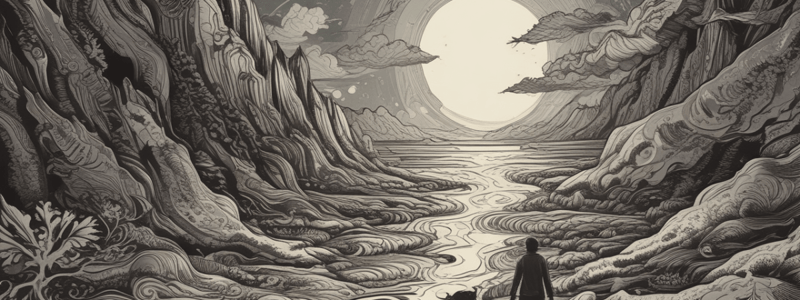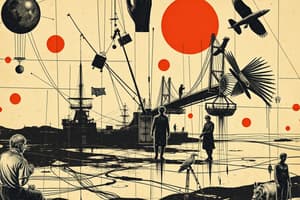Podcast
Questions and Answers
What is visual art primarily created for?
What is visual art primarily created for?
- For commercial purposes
- To be appreciated for its aesthetic or intellectual value (correct)
- To convey a message
- To preserve history
What is the earliest recorded form of visual art?
What is the earliest recorded form of visual art?
- Photography
- Cubism
- Cave paintings (correct)
- Abstract Expressionism
Which art movement introduced new techniques and ideas in visual art?
Which art movement introduced new techniques and ideas in visual art?
- Renaissance
- Impressionism
- Cubism
- All of the above (correct)
What is a fundamental difference between drawing and painting?
What is a fundamental difference between drawing and painting?
What can be used as materials in sculpture?
What can be used as materials in sculpture?
What has led to the rise of amateur and professional photographers alike?
What has led to the rise of amateur and professional photographers alike?
What is a common theme among sculptures?
What is a common theme among sculptures?
What allows photography to freeze moments in time?
What allows photography to freeze moments in time?
What is the primary purpose of considering space in a composition?
What is the primary purpose of considering space in a composition?
What is the role of composition in an artwork?
What is the role of composition in an artwork?
What is the term for the area within, around, and between objects in a composition?
What is the term for the area within, around, and between objects in a composition?
What is the result of understanding the elements of visual art?
What is the result of understanding the elements of visual art?
Why do artists use the elements of visual art in unique and creative ways?
Why do artists use the elements of visual art in unique and creative ways?
What is the benefit of exploring and reflecting on the elements in different artworks?
What is the benefit of exploring and reflecting on the elements in different artworks?
What is the primary medium used in printmaking?
What is the primary medium used in printmaking?
What is a key benefit of digital art?
What is a key benefit of digital art?
What is the primary function of line in visual art?
What is the primary function of line in visual art?
What is the term for the two-dimensional area created by enclosing a line or multiple lines?
What is the term for the two-dimensional area created by enclosing a line or multiple lines?
What is the term for the surface quality of an object or artwork?
What is the term for the surface quality of an object or artwork?
What is the primary function of value in visual art?
What is the primary function of value in visual art?
What is the term for the relative lightness or darkness of a color or tone?
What is the term for the relative lightness or darkness of a color or tone?
What is the primary benefit of understanding the elements of visual art?
What is the primary benefit of understanding the elements of visual art?
What is the term for the three main properties of color?
What is the term for the three main properties of color?
What is a common style of art that involves creating realistic representations of the world?
What is a common style of art that involves creating realistic representations of the world?
Study Notes
Introduction to Visual Art
- Visual art refers to the creation of visual images or objects appreciated for their aesthetic or intellectual value.
- It encompasses various forms such as paintings, sculptures, photography, printmaking, and digital art.
History of Visual Art
- Visual art has a rich history dating back to prehistoric times when early humans created cave paintings.
- It has evolved through different art movements such as Renaissance, Baroque, Impressionism, Cubism, and Abstract Expressionism.
Drawing and Painting
- Drawing involves using lines to depict objects and create a composition.
- Painting involves applying pigments onto a surface, which can be paper, canvas, or even walls.
- Different mediums such as watercolors, acrylics, oils, and gouache offer different textures and effects.
Sculpture
- Sculpture involves creating three-dimensional objects by sculpting, carving, modeling, or assembling materials.
- Sculptures can be representational, abstract, or conceptual, and range in size from small figurines to large installations.
Photography
- Photography involves capturing images using a camera, allowing artists to freeze moments in time.
- Photographers use various techniques, composition, lighting, and editing to create visually appealing and emotive images.
Printmaking
- Printmaking involves creating multiple images, usually on paper, using various methods.
- Techniques such as relief printing, intaglio printing, lithography, and screen printing produce unique textures and effects.
Digital Art
- Digital art involves creating art using digital tools and software such as graphic tablets and image editing programs.
- Digital artists can create illustrations, paintings, animations, and even interactive installations.
Artistic Techniques and Styles
- Techniques such as perspective, shading, color theory, and composition play crucial roles in creating visually appealing artworks.
- Styles range from realism, impressionism, abstract, expressionism, surrealism, and many more, each carrying its own unique characteristics and meanings.
Elements of Visual Art
- Line: a continuous mark made on a surface, with varying characteristics such as thickness, length, direction, and curve.
- Shape: a two-dimensional area created by enclosing a line or multiple lines, which can be geometric or organic.
- Color: derived from light, consisting of hue, value, and intensity.
- Texture: the surface quality of an object or artwork, perceived through touch or visual cues.
- Value: the relative lightness or darkness of a color or tone, creating a sense of depth, form, and volume.
- Space: the area within, around, and between objects in a composition, which can be positive or negative.
- Composition: the arrangement and organization of visual elements within an artwork, guiding the viewer's gaze and conveying a specific message.
Studying That Suits You
Use AI to generate personalized quizzes and flashcards to suit your learning preferences.
Description
Explore the various techniques used in photography and printmaking to create visually appealing images. Learn about composition, lighting, editing, and different printmaking methods.




